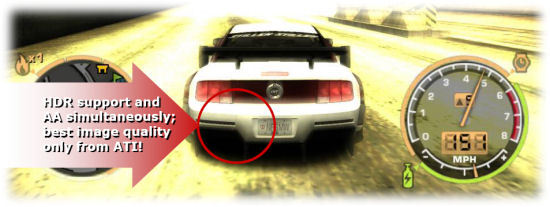ATI leads a week of graphics news with rollout of Mobility X1800, X1800 XT
Markham (ON) - Citing figures from Mercury Research that give it a 77% market share in the so-called "Mobile Discrete" market space (after having claimed 72.5% just last December, based on IDC's numbers), ATI made its next step into the high-performance mobile graphics space with the introduction today of its Mobility Radeon X1800 and X1800 XT, the mobile counterparts to similarly designated desktop GPU cards ATI introduced last October.
The X1800 series also represent ATI's latest venture into the 90 nm fabrication space, which enables its GPUs to consume less power and fit more tightly into cramped spaces than the earlier 110 nm generation. But under the hood, the X1800 isn't exactly a replicate of the desktop GPU of the same name, though it comes as close as is physically feasible for now, ATI's senior product marketing manager, Darren McPhee, told reporters last week. Mobility X1800's engine clock speed has been designed to run at 450 MHz, which is more temperate than its desktop counterpart (X1800 XL) engine clock speed of 500 MHz; and Mobility X1800's memory clock speed of 500 MHz is somewhat cooler than X1800 XL's 1.0 GHz. Likewise, Mobility X1800XT's engine and memory clock speeds are 550 MHz and 650 MHz, respectively, compared to its desktop counterpart speeds of 625 MHz and 1.25 GHz.
So why isn't the Mobility X1800 series everything you can get on the desktop side, only smaller? Because that's not yet physically possible, acknowledged McPhee. While you'd think the company should be able to build off of the momentum of X1600 on the desktop platform, he said, the dynamics of mobile platforms are different. ATI could evolve mobile GPU performance infinitely, he told reporters, if the design of the notebook computer chassis didn't play such a critical role. With not only desktop system designers but the users themselves crafting new and effective cooling mechanisms, ATI could conceivably announce new desktop performance at any point, he said; but in the mobile space, "we're tied into the platform."
It's these physical limitations that are preventing ATI from just going ahead and launching "Mobility Crossfire," which would theoretically introduce dual-GPU capability to the mobile space. Right now, McPhee said, there isn't a mobile platform cool enough - even with 90 nm fabrication of the GPU core - to withstand the heat generation beyond a notebook's own battery life cycle. It is literally up to notebook system builders, he remarked, to decide whether enough of their customers would want dual-GPU notebook performance, before ATI would be permitted to take what would otherwise be characterized as, he said, "the next logical step."
A demonstration of ATI's Mobility X1800 rendering, blending high dynamic range (HDR) with anti-aliasing (AA). (Courtesy ATI Corp.)
What provides the feature similarity between Mobility X1800 series and its desktop counterparts, ATI says, is its coupling of high dynamic range (HDR) with anti-aliasing. HDR, simply put, refers to the breadth of contrast between the darkest darks and the brightest brights in a rendered 3D image. Turning up this contrast does make objects seems more realistic, ATI contends, but only if you squint, letting your eyes do the anti-aliasing that the GPU neglected to do. Anti-aliasing eliminates the "jaggies" that HDR can make more pronounced, ATI demonstrated, smoothing out subtle contours such as the gentle bend of a Ford Mustang's rear bumper, and thus distinguishing the full and proper gaming experience from frustration, despair, and deeply traumatic and incurable mental anguish.
Last month, ATI's director of technical marketing, Alexis Mather, informed TG Daily of Microsoft's plan to elevate the role of its Windows System Performance Rating, to become a marketing tool in helping consumers decide which software is rated to work best with which components. While ATI spokespeople have all declined comment since that time on whether Mobility X1800 and X1800 XT constitutes a "5" on the new WSPR scale of 1 to 5, Darren McPhee did tell TG Daily that these new GPUs are both "Vista-capable," and have been tested with the latest CTP (Build 5308). However, McPhee refused to go so far as to parse language with us, acknowledging that Microsoft has a variety of plans in store for its descriptive adjectives, including "capable," "compliant," and "ready," that ATI may not even know about yet. He added that ATI is not ready at this time to state unequivocally that any of its mobile GPUs in the X1000 series, including its newest ones, will run Microsoft's upcoming DirectX 10 graphics drivers without modification. DirectX 10 compliance, based on our best indications to date, may be required for components to qualify for Microsoft's upcoming "Premium" logo program for Vista.
Get Tom's Hardware's best news and in-depth reviews, straight to your inbox.
Based on that information, no one - not Microsoft, not ATI, and certainly not anyone in the press - may be able to say for certain whether even ATI's top-of-the-line mobile graphics products, introduced just today, will provide the performance levels that Microsoft has in mind for Windows Vista-based mobile systems. And if ATI is waiting for notebook manufacturers to radically improve the way their systems are cooled (perhaps a dose of "cold fusion" could help) then ironically, the company said to be working more closely with Microsoft than Nvidia or even Intel in developing the next wave of computer platforms, may find itself stuck between a hard place and the laws of physics.
